Essay on White Privilege, Intersectionality, and Cultural Competencies
VerifiedAdded on 2021/02/19
|7
|2137
|32
Essay
AI Summary
This essay delves into the multifaceted concepts of white privilege, intersectionality, and cultural competencies, examining their impact on diverse groups within Australian society. It begins by defining white privilege as the unearned advantages afforded to white individuals, contrasting it with the experiences of non-white individuals and indigenous populations. The essay then explores intersectionality, highlighting how various social categories such as gender, race, and class intersect to create overlapping systems of disadvantage. Furthermore, it investigates cultural competencies, emphasizing their role in supporting diverse groups and promoting equitable healthcare practices. The essay argues that understanding white privilege and intersectionality is crucial for healthcare practitioners to provide inclusive and culturally sensitive care, ultimately advocating for social justice and the elimination of disparities. The essay concludes by underscoring the importance of recognizing and addressing biases to ensure equal treatment for all individuals.

Research Essay
Paraphrase This Document
Need a fresh take? Get an instant paraphrase of this document with our AI Paraphraser

Table of Contents
INTRODUCTION...........................................................................................................................1
White privilege.................................................................................................................................1
Intersectionality................................................................................................................................2
Cultural competencies......................................................................................................................3
Conclusion.......................................................................................................................................4
REFERENCES ...............................................................................................................................5
INTRODUCTION...........................................................................................................................1
White privilege.................................................................................................................................1
Intersectionality................................................................................................................................2
Cultural competencies......................................................................................................................3
Conclusion.......................................................................................................................................4
REFERENCES ...............................................................................................................................5
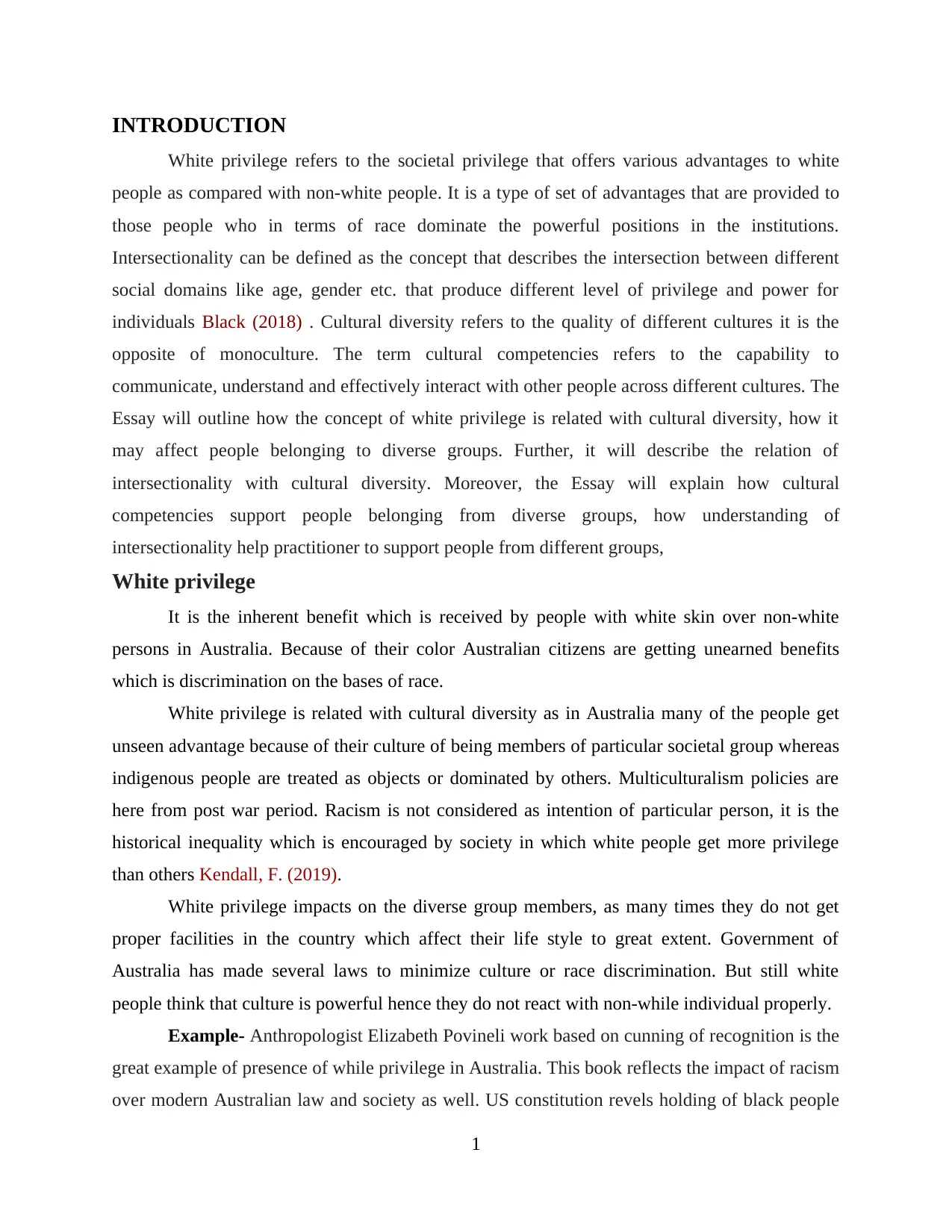
INTRODUCTION
White privilege refers to the societal privilege that offers various advantages to white
people as compared with non-white people. It is a type of set of advantages that are provided to
those people who in terms of race dominate the powerful positions in the institutions.
Intersectionality can be defined as the concept that describes the intersection between different
social domains like age, gender etc. that produce different level of privilege and power for
individuals Black (2018) . Cultural diversity refers to the quality of different cultures it is the
opposite of monoculture. The term cultural competencies refers to the capability to
communicate, understand and effectively interact with other people across different cultures. The
Essay will outline how the concept of white privilege is related with cultural diversity, how it
may affect people belonging to diverse groups. Further, it will describe the relation of
intersectionality with cultural diversity. Moreover, the Essay will explain how cultural
competencies support people belonging from diverse groups, how understanding of
intersectionality help practitioner to support people from different groups,
White privilege
It is the inherent benefit which is received by people with white skin over non-white
persons in Australia. Because of their color Australian citizens are getting unearned benefits
which is discrimination on the bases of race.
White privilege is related with cultural diversity as in Australia many of the people get
unseen advantage because of their culture of being members of particular societal group whereas
indigenous people are treated as objects or dominated by others. Multiculturalism policies are
here from post war period. Racism is not considered as intention of particular person, it is the
historical inequality which is encouraged by society in which white people get more privilege
than others Kendall, F. (2019).
White privilege impacts on the diverse group members, as many times they do not get
proper facilities in the country which affect their life style to great extent. Government of
Australia has made several laws to minimize culture or race discrimination. But still white
people think that culture is powerful hence they do not react with non-while individual properly.
Example- Anthropologist Elizabeth Povineli work based on cunning of recognition is the
great example of presence of while privilege in Australia. This book reflects the impact of racism
over modern Australian law and society as well. US constitution revels holding of black people
1
White privilege refers to the societal privilege that offers various advantages to white
people as compared with non-white people. It is a type of set of advantages that are provided to
those people who in terms of race dominate the powerful positions in the institutions.
Intersectionality can be defined as the concept that describes the intersection between different
social domains like age, gender etc. that produce different level of privilege and power for
individuals Black (2018) . Cultural diversity refers to the quality of different cultures it is the
opposite of monoculture. The term cultural competencies refers to the capability to
communicate, understand and effectively interact with other people across different cultures. The
Essay will outline how the concept of white privilege is related with cultural diversity, how it
may affect people belonging to diverse groups. Further, it will describe the relation of
intersectionality with cultural diversity. Moreover, the Essay will explain how cultural
competencies support people belonging from diverse groups, how understanding of
intersectionality help practitioner to support people from different groups,
White privilege
It is the inherent benefit which is received by people with white skin over non-white
persons in Australia. Because of their color Australian citizens are getting unearned benefits
which is discrimination on the bases of race.
White privilege is related with cultural diversity as in Australia many of the people get
unseen advantage because of their culture of being members of particular societal group whereas
indigenous people are treated as objects or dominated by others. Multiculturalism policies are
here from post war period. Racism is not considered as intention of particular person, it is the
historical inequality which is encouraged by society in which white people get more privilege
than others Kendall, F. (2019).
White privilege impacts on the diverse group members, as many times they do not get
proper facilities in the country which affect their life style to great extent. Government of
Australia has made several laws to minimize culture or race discrimination. But still white
people think that culture is powerful hence they do not react with non-while individual properly.
Example- Anthropologist Elizabeth Povineli work based on cunning of recognition is the
great example of presence of while privilege in Australia. This book reflects the impact of racism
over modern Australian law and society as well. US constitution revels holding of black people
1
⊘ This is a preview!⊘
Do you want full access?
Subscribe today to unlock all pages.

Trusted by 1+ million students worldwide
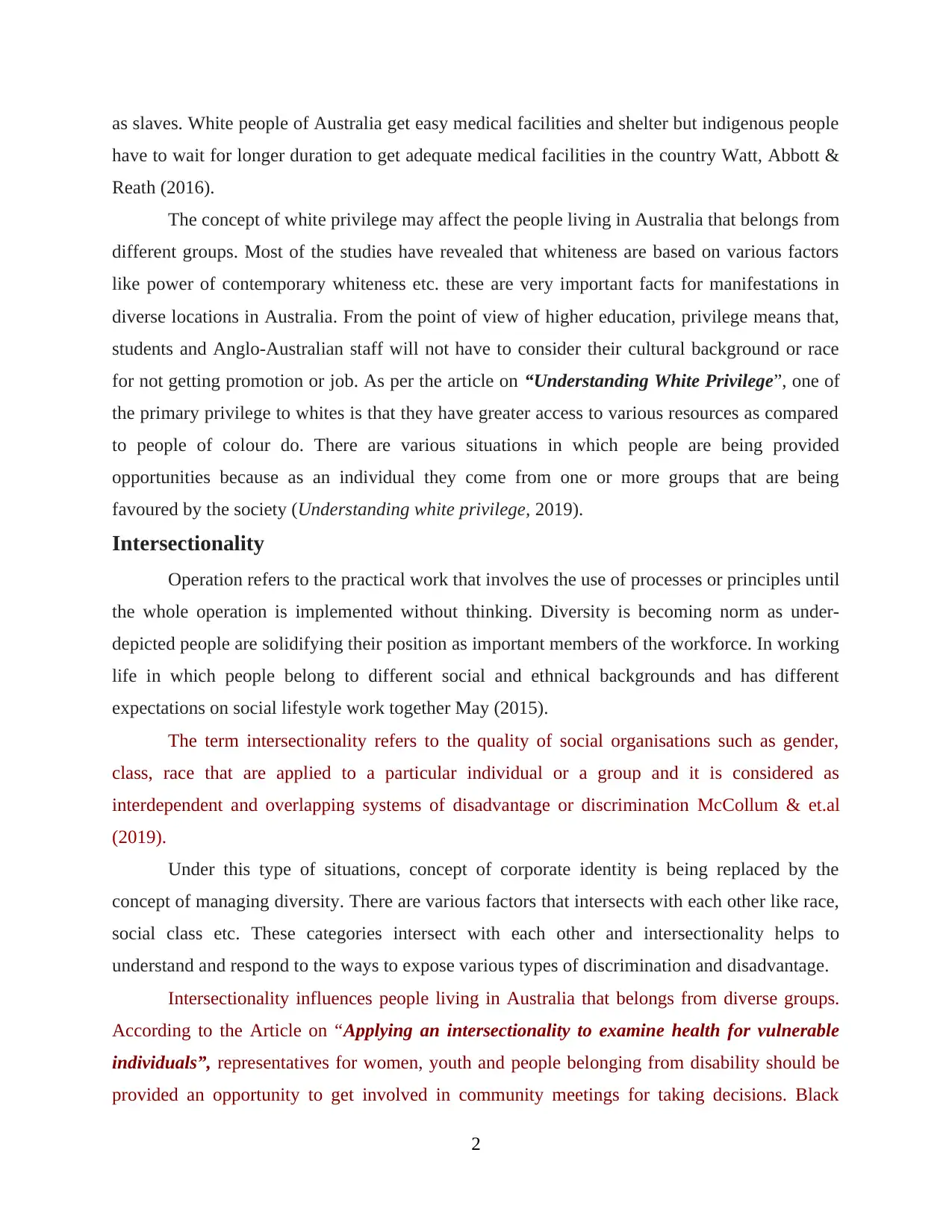
as slaves. White people of Australia get easy medical facilities and shelter but indigenous people
have to wait for longer duration to get adequate medical facilities in the country Watt, Abbott &
Reath (2016).
The concept of white privilege may affect the people living in Australia that belongs from
different groups. Most of the studies have revealed that whiteness are based on various factors
like power of contemporary whiteness etc. these are very important facts for manifestations in
diverse locations in Australia. From the point of view of higher education, privilege means that,
students and Anglo-Australian staff will not have to consider their cultural background or race
for not getting promotion or job. As per the article on “Understanding White Privilege”, one of
the primary privilege to whites is that they have greater access to various resources as compared
to people of colour do. There are various situations in which people are being provided
opportunities because as an individual they come from one or more groups that are being
favoured by the society (Understanding white privilege, 2019).
Intersectionality
Operation refers to the practical work that involves the use of processes or principles until
the whole operation is implemented without thinking. Diversity is becoming norm as under-
depicted people are solidifying their position as important members of the workforce. In working
life in which people belong to different social and ethnical backgrounds and has different
expectations on social lifestyle work together May (2015).
The term intersectionality refers to the quality of social organisations such as gender,
class, race that are applied to a particular individual or a group and it is considered as
interdependent and overlapping systems of disadvantage or discrimination McCollum & et.al
(2019).
Under this type of situations, concept of corporate identity is being replaced by the
concept of managing diversity. There are various factors that intersects with each other like race,
social class etc. These categories intersect with each other and intersectionality helps to
understand and respond to the ways to expose various types of discrimination and disadvantage.
Intersectionality influences people living in Australia that belongs from diverse groups.
According to the Article on “Applying an intersectionality to examine health for vulnerable
individuals”, representatives for women, youth and people belonging from disability should be
provided an opportunity to get involved in community meetings for taking decisions. Black
2
have to wait for longer duration to get adequate medical facilities in the country Watt, Abbott &
Reath (2016).
The concept of white privilege may affect the people living in Australia that belongs from
different groups. Most of the studies have revealed that whiteness are based on various factors
like power of contemporary whiteness etc. these are very important facts for manifestations in
diverse locations in Australia. From the point of view of higher education, privilege means that,
students and Anglo-Australian staff will not have to consider their cultural background or race
for not getting promotion or job. As per the article on “Understanding White Privilege”, one of
the primary privilege to whites is that they have greater access to various resources as compared
to people of colour do. There are various situations in which people are being provided
opportunities because as an individual they come from one or more groups that are being
favoured by the society (Understanding white privilege, 2019).
Intersectionality
Operation refers to the practical work that involves the use of processes or principles until
the whole operation is implemented without thinking. Diversity is becoming norm as under-
depicted people are solidifying their position as important members of the workforce. In working
life in which people belong to different social and ethnical backgrounds and has different
expectations on social lifestyle work together May (2015).
The term intersectionality refers to the quality of social organisations such as gender,
class, race that are applied to a particular individual or a group and it is considered as
interdependent and overlapping systems of disadvantage or discrimination McCollum & et.al
(2019).
Under this type of situations, concept of corporate identity is being replaced by the
concept of managing diversity. There are various factors that intersects with each other like race,
social class etc. These categories intersect with each other and intersectionality helps to
understand and respond to the ways to expose various types of discrimination and disadvantage.
Intersectionality influences people living in Australia that belongs from diverse groups.
According to the Article on “Applying an intersectionality to examine health for vulnerable
individuals”, representatives for women, youth and people belonging from disability should be
provided an opportunity to get involved in community meetings for taking decisions. Black
2
Paraphrase This Document
Need a fresh take? Get an instant paraphrase of this document with our AI Paraphraser
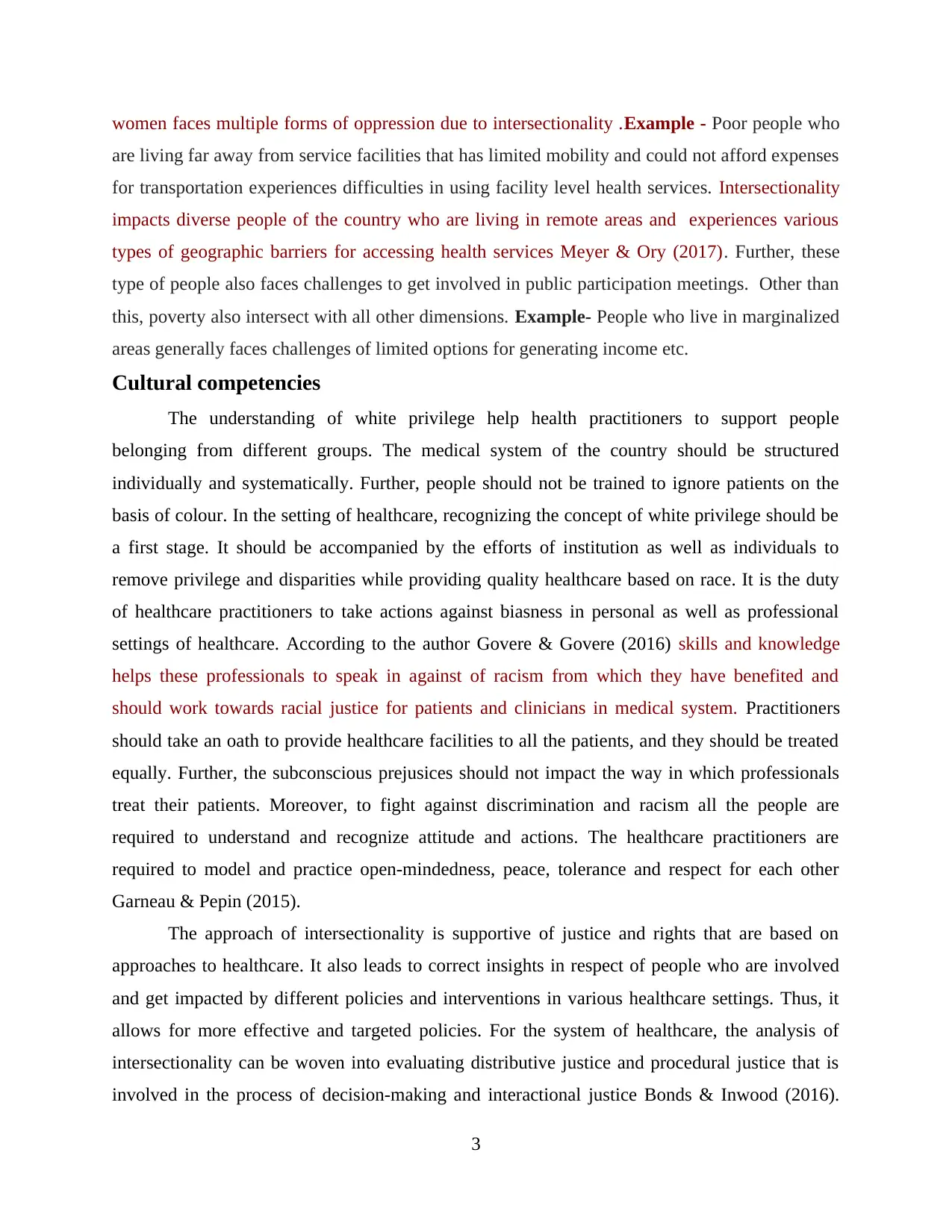
women faces multiple forms of oppression due to intersectionality .Example - Poor people who
are living far away from service facilities that has limited mobility and could not afford expenses
for transportation experiences difficulties in using facility level health services. Intersectionality
impacts diverse people of the country who are living in remote areas and experiences various
types of geographic barriers for accessing health services Meyer & Ory (2017). Further, these
type of people also faces challenges to get involved in public participation meetings. Other than
this, poverty also intersect with all other dimensions. Example- People who live in marginalized
areas generally faces challenges of limited options for generating income etc.
Cultural competencies
The understanding of white privilege help health practitioners to support people
belonging from different groups. The medical system of the country should be structured
individually and systematically. Further, people should not be trained to ignore patients on the
basis of colour. In the setting of healthcare, recognizing the concept of white privilege should be
a first stage. It should be accompanied by the efforts of institution as well as individuals to
remove privilege and disparities while providing quality healthcare based on race. It is the duty
of healthcare practitioners to take actions against biasness in personal as well as professional
settings of healthcare. According to the author Govere & Govere (2016) skills and knowledge
helps these professionals to speak in against of racism from which they have benefited and
should work towards racial justice for patients and clinicians in medical system. Practitioners
should take an oath to provide healthcare facilities to all the patients, and they should be treated
equally. Further, the subconscious prejusices should not impact the way in which professionals
treat their patients. Moreover, to fight against discrimination and racism all the people are
required to understand and recognize attitude and actions. The healthcare practitioners are
required to model and practice open-mindedness, peace, tolerance and respect for each other
Garneau & Pepin (2015).
The approach of intersectionality is supportive of justice and rights that are based on
approaches to healthcare. It also leads to correct insights in respect of people who are involved
and get impacted by different policies and interventions in various healthcare settings. Thus, it
allows for more effective and targeted policies. For the system of healthcare, the analysis of
intersectionality can be woven into evaluating distributive justice and procedural justice that is
involved in the process of decision-making and interactional justice Bonds & Inwood (2016).
3
are living far away from service facilities that has limited mobility and could not afford expenses
for transportation experiences difficulties in using facility level health services. Intersectionality
impacts diverse people of the country who are living in remote areas and experiences various
types of geographic barriers for accessing health services Meyer & Ory (2017). Further, these
type of people also faces challenges to get involved in public participation meetings. Other than
this, poverty also intersect with all other dimensions. Example- People who live in marginalized
areas generally faces challenges of limited options for generating income etc.
Cultural competencies
The understanding of white privilege help health practitioners to support people
belonging from different groups. The medical system of the country should be structured
individually and systematically. Further, people should not be trained to ignore patients on the
basis of colour. In the setting of healthcare, recognizing the concept of white privilege should be
a first stage. It should be accompanied by the efforts of institution as well as individuals to
remove privilege and disparities while providing quality healthcare based on race. It is the duty
of healthcare practitioners to take actions against biasness in personal as well as professional
settings of healthcare. According to the author Govere & Govere (2016) skills and knowledge
helps these professionals to speak in against of racism from which they have benefited and
should work towards racial justice for patients and clinicians in medical system. Practitioners
should take an oath to provide healthcare facilities to all the patients, and they should be treated
equally. Further, the subconscious prejusices should not impact the way in which professionals
treat their patients. Moreover, to fight against discrimination and racism all the people are
required to understand and recognize attitude and actions. The healthcare practitioners are
required to model and practice open-mindedness, peace, tolerance and respect for each other
Garneau & Pepin (2015).
The approach of intersectionality is supportive of justice and rights that are based on
approaches to healthcare. It also leads to correct insights in respect of people who are involved
and get impacted by different policies and interventions in various healthcare settings. Thus, it
allows for more effective and targeted policies. For the system of healthcare, the analysis of
intersectionality can be woven into evaluating distributive justice and procedural justice that is
involved in the process of decision-making and interactional justice Bonds & Inwood (2016).
3
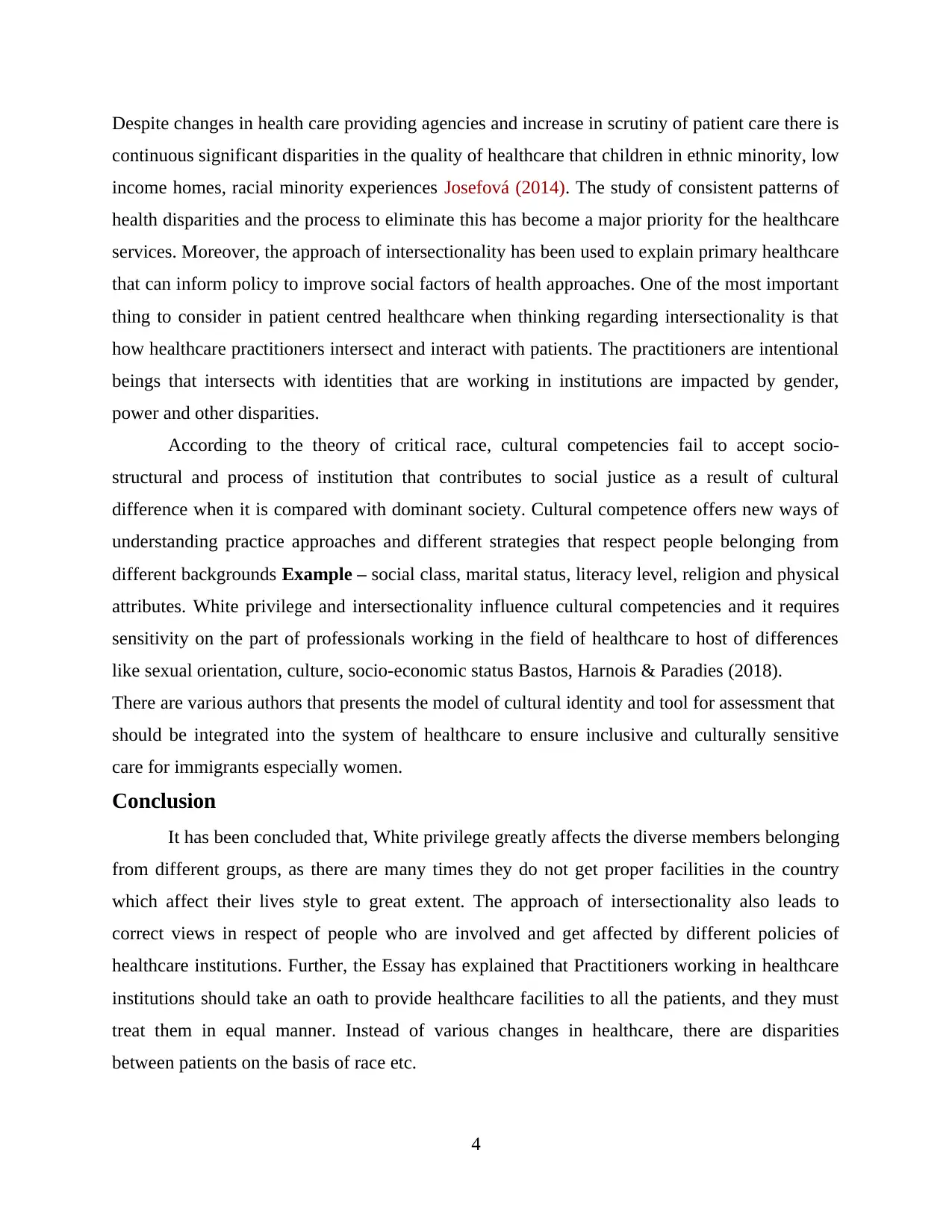
Despite changes in health care providing agencies and increase in scrutiny of patient care there is
continuous significant disparities in the quality of healthcare that children in ethnic minority, low
income homes, racial minority experiences Josefová (2014). The study of consistent patterns of
health disparities and the process to eliminate this has become a major priority for the healthcare
services. Moreover, the approach of intersectionality has been used to explain primary healthcare
that can inform policy to improve social factors of health approaches. One of the most important
thing to consider in patient centred healthcare when thinking regarding intersectionality is that
how healthcare practitioners intersect and interact with patients. The practitioners are intentional
beings that intersects with identities that are working in institutions are impacted by gender,
power and other disparities.
According to the theory of critical race, cultural competencies fail to accept socio-
structural and process of institution that contributes to social justice as a result of cultural
difference when it is compared with dominant society. Cultural competence offers new ways of
understanding practice approaches and different strategies that respect people belonging from
different backgrounds Example – social class, marital status, literacy level, religion and physical
attributes. White privilege and intersectionality influence cultural competencies and it requires
sensitivity on the part of professionals working in the field of healthcare to host of differences
like sexual orientation, culture, socio-economic status Bastos, Harnois & Paradies (2018).
There are various authors that presents the model of cultural identity and tool for assessment that
should be integrated into the system of healthcare to ensure inclusive and culturally sensitive
care for immigrants especially women.
Conclusion
It has been concluded that, White privilege greatly affects the diverse members belonging
from different groups, as there are many times they do not get proper facilities in the country
which affect their lives style to great extent. The approach of intersectionality also leads to
correct views in respect of people who are involved and get affected by different policies of
healthcare institutions. Further, the Essay has explained that Practitioners working in healthcare
institutions should take an oath to provide healthcare facilities to all the patients, and they must
treat them in equal manner. Instead of various changes in healthcare, there are disparities
between patients on the basis of race etc.
4
continuous significant disparities in the quality of healthcare that children in ethnic minority, low
income homes, racial minority experiences Josefová (2014). The study of consistent patterns of
health disparities and the process to eliminate this has become a major priority for the healthcare
services. Moreover, the approach of intersectionality has been used to explain primary healthcare
that can inform policy to improve social factors of health approaches. One of the most important
thing to consider in patient centred healthcare when thinking regarding intersectionality is that
how healthcare practitioners intersect and interact with patients. The practitioners are intentional
beings that intersects with identities that are working in institutions are impacted by gender,
power and other disparities.
According to the theory of critical race, cultural competencies fail to accept socio-
structural and process of institution that contributes to social justice as a result of cultural
difference when it is compared with dominant society. Cultural competence offers new ways of
understanding practice approaches and different strategies that respect people belonging from
different backgrounds Example – social class, marital status, literacy level, religion and physical
attributes. White privilege and intersectionality influence cultural competencies and it requires
sensitivity on the part of professionals working in the field of healthcare to host of differences
like sexual orientation, culture, socio-economic status Bastos, Harnois & Paradies (2018).
There are various authors that presents the model of cultural identity and tool for assessment that
should be integrated into the system of healthcare to ensure inclusive and culturally sensitive
care for immigrants especially women.
Conclusion
It has been concluded that, White privilege greatly affects the diverse members belonging
from different groups, as there are many times they do not get proper facilities in the country
which affect their lives style to great extent. The approach of intersectionality also leads to
correct views in respect of people who are involved and get affected by different policies of
healthcare institutions. Further, the Essay has explained that Practitioners working in healthcare
institutions should take an oath to provide healthcare facilities to all the patients, and they must
treat them in equal manner. Instead of various changes in healthcare, there are disparities
between patients on the basis of race etc.
4
⊘ This is a preview!⊘
Do you want full access?
Subscribe today to unlock all pages.

Trusted by 1+ million students worldwide
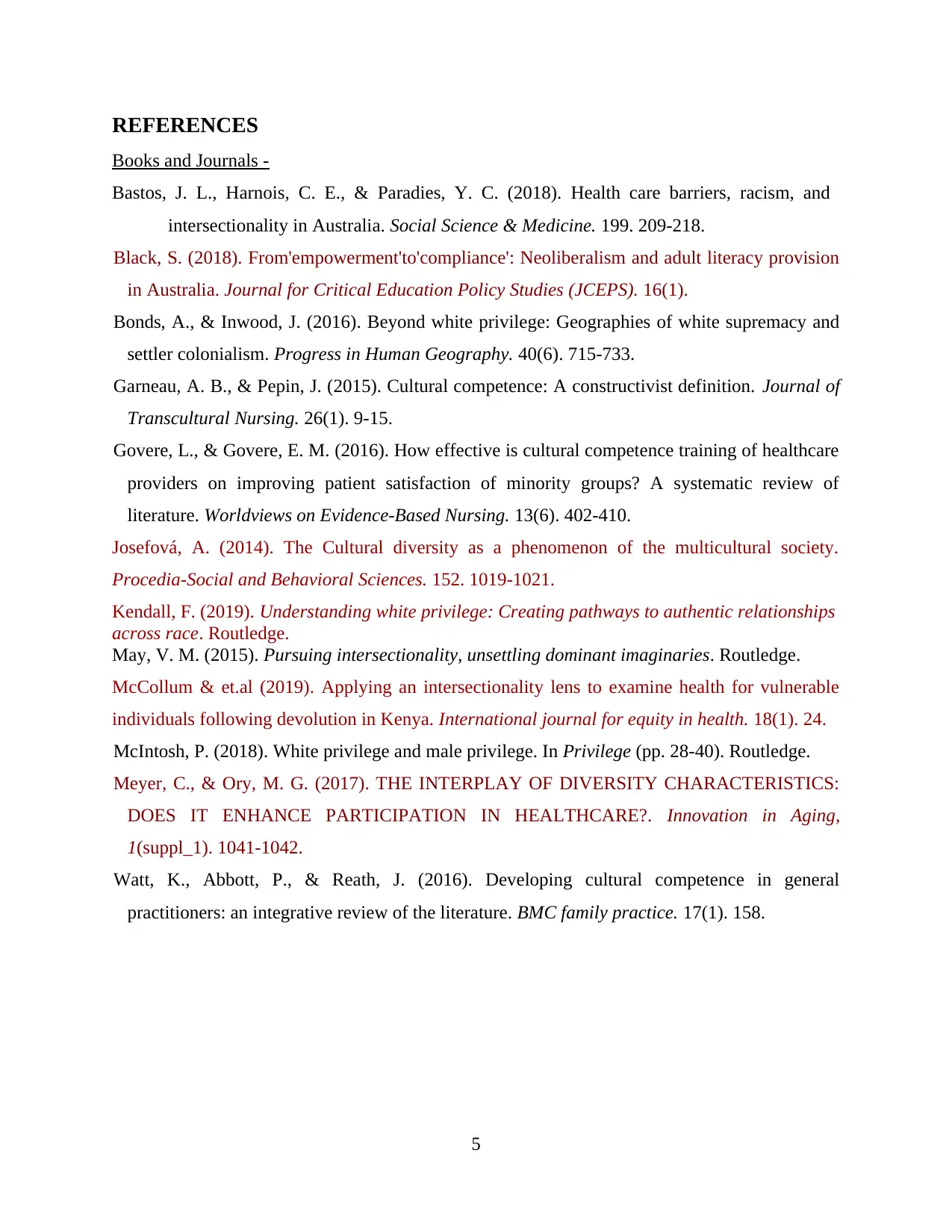
REFERENCES
Books and Journals -
Bastos, J. L., Harnois, C. E., & Paradies, Y. C. (2018). Health care barriers, racism, and
intersectionality in Australia. Social Science & Medicine. 199. 209-218.
Black, S. (2018). From'empowerment'to'compliance': Neoliberalism and adult literacy provision
in Australia. Journal for Critical Education Policy Studies (JCEPS). 16(1).
Bonds, A., & Inwood, J. (2016). Beyond white privilege: Geographies of white supremacy and
settler colonialism. Progress in Human Geography. 40(6). 715-733.
Garneau, A. B., & Pepin, J. (2015). Cultural competence: A constructivist definition. Journal of
Transcultural Nursing. 26(1). 9-15.
Govere, L., & Govere, E. M. (2016). How effective is cultural competence training of healthcare
providers on improving patient satisfaction of minority groups? A systematic review of
literature. Worldviews on Evidence‐Based Nursing. 13(6). 402-410.
Josefová, A. (2014). The Cultural diversity as a phenomenon of the multicultural society.
Procedia-Social and Behavioral Sciences. 152. 1019-1021.
Kendall, F. (2019). Understanding white privilege: Creating pathways to authentic relationships
across race. Routledge.
May, V. M. (2015). Pursuing intersectionality, unsettling dominant imaginaries. Routledge.
McCollum & et.al (2019). Applying an intersectionality lens to examine health for vulnerable
individuals following devolution in Kenya. International journal for equity in health. 18(1). 24.
McIntosh, P. (2018). White privilege and male privilege. In Privilege (pp. 28-40). Routledge.
Meyer, C., & Ory, M. G. (2017). THE INTERPLAY OF DIVERSITY CHARACTERISTICS:
DOES IT ENHANCE PARTICIPATION IN HEALTHCARE?. Innovation in Aging,
1(suppl_1). 1041-1042.
Watt, K., Abbott, P., & Reath, J. (2016). Developing cultural competence in general
practitioners: an integrative review of the literature. BMC family practice. 17(1). 158.
5
Books and Journals -
Bastos, J. L., Harnois, C. E., & Paradies, Y. C. (2018). Health care barriers, racism, and
intersectionality in Australia. Social Science & Medicine. 199. 209-218.
Black, S. (2018). From'empowerment'to'compliance': Neoliberalism and adult literacy provision
in Australia. Journal for Critical Education Policy Studies (JCEPS). 16(1).
Bonds, A., & Inwood, J. (2016). Beyond white privilege: Geographies of white supremacy and
settler colonialism. Progress in Human Geography. 40(6). 715-733.
Garneau, A. B., & Pepin, J. (2015). Cultural competence: A constructivist definition. Journal of
Transcultural Nursing. 26(1). 9-15.
Govere, L., & Govere, E. M. (2016). How effective is cultural competence training of healthcare
providers on improving patient satisfaction of minority groups? A systematic review of
literature. Worldviews on Evidence‐Based Nursing. 13(6). 402-410.
Josefová, A. (2014). The Cultural diversity as a phenomenon of the multicultural society.
Procedia-Social and Behavioral Sciences. 152. 1019-1021.
Kendall, F. (2019). Understanding white privilege: Creating pathways to authentic relationships
across race. Routledge.
May, V. M. (2015). Pursuing intersectionality, unsettling dominant imaginaries. Routledge.
McCollum & et.al (2019). Applying an intersectionality lens to examine health for vulnerable
individuals following devolution in Kenya. International journal for equity in health. 18(1). 24.
McIntosh, P. (2018). White privilege and male privilege. In Privilege (pp. 28-40). Routledge.
Meyer, C., & Ory, M. G. (2017). THE INTERPLAY OF DIVERSITY CHARACTERISTICS:
DOES IT ENHANCE PARTICIPATION IN HEALTHCARE?. Innovation in Aging,
1(suppl_1). 1041-1042.
Watt, K., Abbott, P., & Reath, J. (2016). Developing cultural competence in general
practitioners: an integrative review of the literature. BMC family practice. 17(1). 158.
5
1 out of 7
Related Documents
Your All-in-One AI-Powered Toolkit for Academic Success.
+13062052269
info@desklib.com
Available 24*7 on WhatsApp / Email
![[object Object]](/_next/static/media/star-bottom.7253800d.svg)
Unlock your academic potential
Copyright © 2020–2025 A2Z Services. All Rights Reserved. Developed and managed by ZUCOL.




